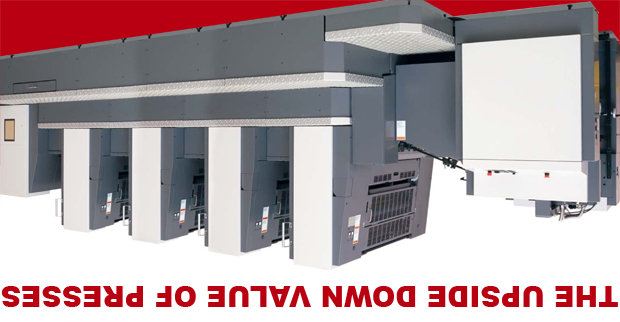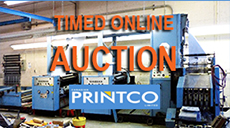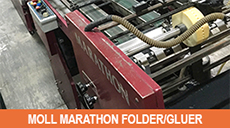
|
|
| Home › Articles › Here |
  |

|
||||||||||||||
| By: Nick Howard | Date: September 2011 | Contact the Author |
|||||||||||||||
Cont'd from Part 1 |
|||||||||||||||
|
Modern and secondary markets Given the modern, breakneck advances in all incarnations of computing technology, heavy-production equipment, whether designed for printing or almost any manufacturing sector, is constantly pressured by newer generation machines – ready to outperform a similar machine introduced just months earlier. The rapid introduction of new machines and technology creates serious challenges and opportunities for our entire industry. A post-hole auger does what is needed. A faster one does it better and that’s the same with machinery. Super-fast augers mean more production at lower costs just as printing equipment does. The reason why we all need to look at new technology is based on the simple premise of constantly changing equipment in a bid to reduce costs and maintain profitability. The knock-on effect is dropping used machine values. The salesperson does not want to explain how their boss says the trade is worth less than the finance. Unless forced into it, the salesperson would not go near such a discussion with a barge pole. The whole process counteracts what suppliers are trying to do. They are trying to up-sell you on new technology; while tiptoeing around why that piece of equipment they sold you four of five years ago now garners such an incredibly low price. What a rotten position befalls any salesperson explaining how the low price is a simple matter of supply and demand – what buyers and sellers are now willing to pay. One must take into account that manufacturers can build machines cheaper than even a few years ago. The tendency is to reduce the amount of components and this also reduces the costs. Computer-driven equipment is also being produced for less each year and, as with capital equipment, provides ever more efficiency and productivity for less cost per revolution. The state of the secondary market also plays a significant role in the trade-in value. Here, supply and demand becomes more complicated, because the usedequipment seller is often at the mercy of global printing market conditions. Many printing machines have been leaving North American over the past few years, which severely depresses the global used machinery market, in terms of pricing. Equipment sells for much less than could be gained if there was more demand here. Although used equipment prices have started to firm up lately, this is being stabilized by a limited supply. Down the road, the used machinery seller or broker who only exports will have the largest negative effect on keeping machine prices low. An aggravating sidebar for the used-equipment story is that many brokers or dealers tend to present a picture of bountiful riches to the printer, leaving the thought of definite proof that the manufacturer does not have a clue about current equipment value – or worse. This scenario sometimes reaches a tragic conclusion where promises made simply cannot be kept. The industry should be mindful of high offers that do not come with non-refundable 25 percent deposits. If I were such a printer, faced with a too-high-to-be-true offer, then getting that hurt money up front settles the case. No big deposit, no sale. New versus used In our current business climate, the key difficulty for suppliers revolves around getting financing for their customers. This problem, arguably, has been a long time coming to the printing industry. Into the near future, printers with the ability to organize and manage financing will be the industry’s top performers, while the rest struggle to understand why they can no longer be competitive without new tools. The argument of new versus used equipment will continue on in this matured industry and any sensible answers must commiserate value in today’s business environment. Our idea of ownership needs some re-work for it to reach a point where the printer can take advantage of next-generation machinery without suffering through the agony, despair and anger over depressed trade-in values. From my recent discussions about asset values, printers have a wide spectrum of emotions from angst to defeatism. Financial institutions and the accounting departments of suppliers look at the problem quite differently. They see how proper depreciation is necessary and use accounting principles to determine an asset value. From my appraisal work, there are many examples of printers who feel taken advantage of by the supplier. These printers do not want to hear or understand that the paper is no longer in the supplier’s hands – and probably never was. Printers become very angry when they then try to alter payment schedules or try to discount an agreement that is, well, an agreement. Capital equipment is not bought in a department store: You bought it and are expected to make it work. So what is the best fix for this upsidedown problem and how can a printer navigate such dangerous waters? Sometimes printers simply do not make it or give up – a fix of sorts, but certainly not high on the options list. If you find yourself in a situation where you need to re-tool and have been through the process, then please do not shout the salesperson out of the office. He or she probably knows the problem already and is also offering a new or newer machine that does more while costing less. Try and look at how you can restructure your loan and keep the financial side happy. Banks and other lenders already consider that devaluations are built in, even past the appraised market value. In many cases, however, you are speaking to a completely new lender. Do not expect any printing machinery, regardless of its origin, to age well in terms of price. But do not dare stop considering new investments, even if there is a loss on the trade. To think otherwise is nonsensical: It is easier to carry a loss and dispose of slower machinery than it is to keep running them with higher costs. The guy with the older, slower post-hole digger gets home later and later, feels good about his costs, but finds he is losing customers as well as working harder just to maintain his business. What makes it an interesting time now is that we are devoid of supplier-manufacturer relationships founded on rubberstamp approvals. Expensive equipment is again only available to those who can get it themselves. Even though there have been many struggling printers over the past couple of years, as we move further into 2011, it is clear printers and suppliers alike are moving through a watershed period in the history of print. Signs of life are already evident. |
|||||||||||||||
| Contact the Author | |||||||||||||||
|
|||||||||||||||





